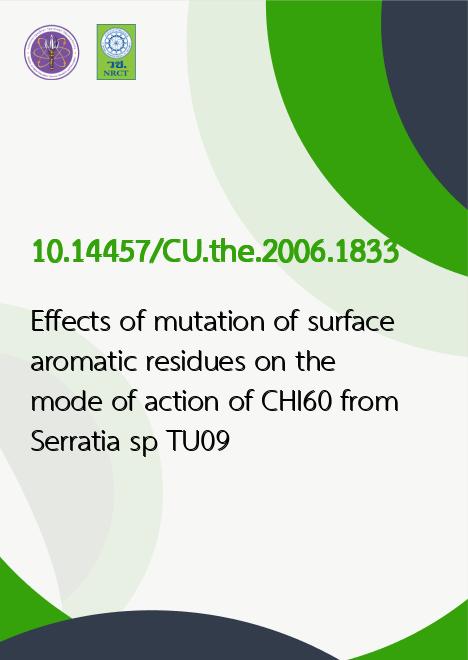
|
Effects of mutation of surface aromatic residues on the mode of action of CHI60 from Serratia sp. TU09 |
|---|---|
| รหัสดีโอไอ | |
| Title | Effects of mutation of surface aromatic residues on the mode of action of CHI60 from Serratia sp. TU09 |
| Creator | Kamontip Kuttiyawong |
| Contributor | Rath Pichyangkura |
| Publisher | Chulalongkorn University |
| Publication Year | 2549 |
| Keyword | Mutation (Biology), Amino acids, Chitinase, Chitin |
| Abstract | Chitinase 60 (CHI60) from Serratia sp.TU09 was cloned, expressed and characterized. The amino acid sequence of CHI60 was identical to ChiA from Serratia marcescens. CHI60 has two functional domains, the N-terminal domain and the ([alpha]+[beta])[subscript 8] barrel catalytic domain. To study the mechanism and mode of action of CHI60, we mutated the exposed Trp residues in the tryptophan track in the N-terminus and the catalytic domain of CHI60 (Trp33, 69, 245, 275 and Tyr418). The interaction these of residues with different types of substrate, soluble, amorphous and crystalline chitin was studied, to investigate the possible role of these residues on the mode of catalysis, exo/endo mode, and mechanism by which the exposed tryptophan track functions on binding and guiding the substrate during processive hydrolysis. Site-directed mutagenesis of Trp residues to Phe, Tyr or Ala was carried out. We found that CHI60 possesses both exo and endo mode of hydrolysis depending on type of substrate it hydrolyzes. CHI60 uses endo mode when it hydrolyzes soluble chitin involving only the catalytic domain, uses both endo and exo mode when it hydrolyzes amorphous chitin and uses exo mode when it processively hydrolyzes -crystalline chitin. We can influence the mode of hydrolysis by CHI60 between the enzyme and substrate by modulating the binding affinity of CHI60 to its substrate. This was accomplished by changing ionic strength of the environment, and/or generating derivatives of CHI60 with mutations on Trp residues in the Tryptophan track, where Trp was changed to Phe or Tyr. This is based on the effect that interaction between the sugar ring and Trp residues is a hydrophobic interaction. We have successfully mutated Trp residues in the exposed tryptophan track at the N-terminus and the catalytic domain of CHI60. The effect of ionic strength on hydrolyzing activity of mutants suggested that Trp33 in the N-terminus and Trp275 in the catalytic domain may play an important role in the processivity of the enzyme. To further confirm the mode of hydrolysis of CHI60 and mutants, we studied the product size distribution by TLC when an amorphous substrate was used. On amorphous substrate CHI60 would be forced to hydrolyze the substrate via the endo mode, which would give multiple size products. We found that at 50 °C, CHI60 used endo mode more than at 37 °C. However at 50 °C, the endo mode of CHI60 was reduced while the exo mode of CHI60 was enhanced by increasing in ionic strength. We used HPLC analysis for further quantitative of product. The results demonstrated that the exo mode of CHI60 was enhanced at elevated ionic strength and substrate was processively hydrolyzed. In addition, the difference in the ratio of the activity of the enzyme at 37 °C versus 50 °C of mutant comparing to WT CHI60, implied that Trp245 may function to guide the insoluble chitin into the catalytic cleft, and W275F, W418A may help to increase the kinetic of the hydrolysis at high temperature on PNAC by facilitating the dissociation of the product from catalytic cleft. On -chitin, single mutants, W33F, W69F and W245Y, with reduced hydrophobic interaction between substrate-enzyme, lose their processivity at higher temperature probably due to weaker enzyme-substrate binding. |
| URL Website | cuir.car.chula.ac.th |